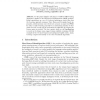104 search results - page 6 / 21 » Word Sense Disambiguation by Relative Selection |
ACL
1996
13 years 8 months ago
1996
In this paper, we present a new approach for word sense disambiguation (WSD) using an exemplar-based learning algorithm. This approach integrates a diverse set of knowledge source...
CICLING
2006
Springer
13 years 11 months ago
2006
Springer
The disambiguation of verbs is usually considered to be more difficult with respect to other part-of-speech categories. This is due both to the high polysemy of verbs compared with...
CORR
2000
Springer
13 years 7 months ago
2000
Springer
In this paper Schapire and Singer's AdaBoost.MH boosting algorithm is applied to the Word Sense Disambiguation (WSD) problem. Initial experiments on a set of 15 selected polys...
FGCN
2008
IEEE
14 years 1 months ago
2008
IEEE
Word sense disambiguation has always been a key problem in Natural Language Processing. In the paper, we use the method of Information Gain to calculate the weight of different po...
LREC
2008
13 years 8 months ago
2008
Word Sense Disambiguation (WSD) is an intermediate task that serves as a means to an end defined by the application in which it is to be used. However, different applications have...

